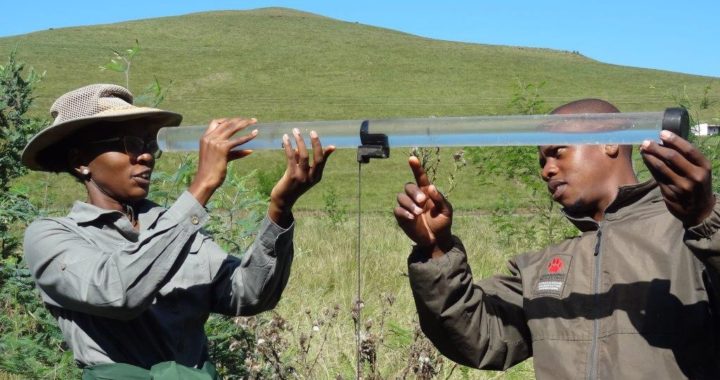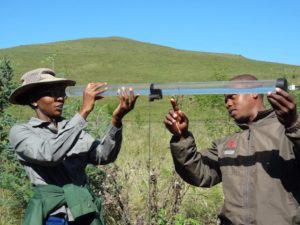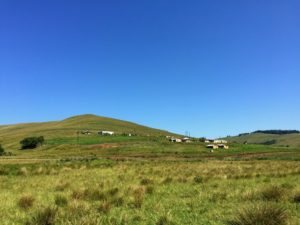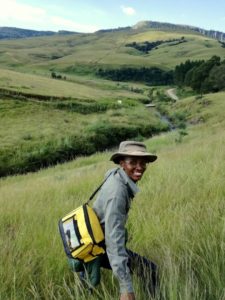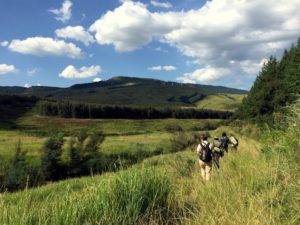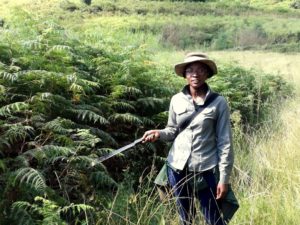On Monday, 27 March the eager walkers were greeted with a clear sky for Day 2 of the Karkloof Catchment to Confluence River Walk. We were thrilled to have Hlengiwe Ndlovu, an environmentalist for Sappi, join us for the day and share her expertise and knowledge with our team for this vitally important project.

Day 2 River Walkers. From Left: Sue Viljoen (WWF-SA), Hlengiwe Ndlovu (SAPPI), Twané Clarke (Karkloof Conservancy), Nduduzo Khoza (EWT) and Ayanda Lipheyana (GroundTruth)
The team were dropped off at the same point that we ended at on the previous day and started a new Riparian Health Audit (RHA) to measure the quality of the upcoming river stretch. A miniSASS study along with water chemistry tests were also conducted.
The journey along this first RHA section yielded a “Fair” result, which had been the lowest score we’d gotten since the source of the Karkloof river. We anticipated that the results would show a decrease in river health, as we had come across the first sign of humans since starting on our walk.
Hlengiwe was enthusiastic about the River walk: “I think the project will provide valuable “point information” of where/what impacts occur along the river for the landowners to enable targeted action. It will also be worthy in providing positive feedback to landowners who’ve completed good rehabilitation interventions.”
This RHA area was badly infested with Wattle and Bramble; there were signs of litter and small scale dumping; and Ayanda Lipheyana of GroundTruth pointed out the “Sewerage plant” which grows along river banks where there is a high nutrient load in the water. This warranted a sample to be taken for E. coli, Nitrate and Phosphate tests to be done. These samples are sent daily to Talbot and Talbot who have kindly donated their time, equipment and expertise for this project.
We soon entered Plantation territory, where the team were treated to interesting stories from Hlengiwe about the challenges they face when planning Invasive Alien Plant control within the plantation areas.
The team were impressed with the progress that has been made by SAPPI in the stretch we were walking for the day.
The riparian zones were looking healthy and we had an easy walk through the grasslands, appreciating the lack of bramble hooking onto our clothes and skin.
Hlengiwe pointed out the Bracken in a few areas, telling us about the nightmare in trying to control this pioneer species. This plant is a common sight in the KZN Midlands, turning a beautiful golden brown colour in the autumn. There was a consensus in the discussions between the team that the most effective way in controlling the spread of this plant is to keep it short and cut the regrowth at its early stages.
As the team saw their homestretch to the end of day 2, Ayanda’s foot managed to find an animal’s home on the grassland slope, unfortunately twisting his ankle in the process. One of the dangers of walking through unpathed areas.
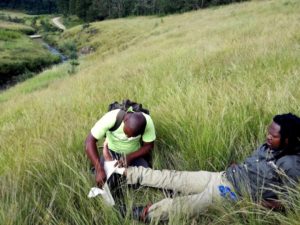
Ayanda getting his ankle strapped by Nduduzo to help him reach our end point at the bridge in the background.
Hlengiwe commented: “I enjoyed being up close and personal to the river, which is a rare opportunity as one often sees the river in bits and pieces. I also enjoyed the anecdotal stories from the team of the different “river experiences” we’d all had and how we’ve all experienced the Karkloof thus far.”
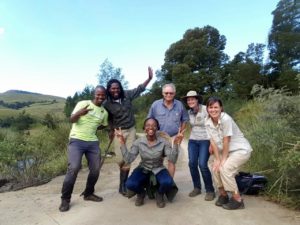
A happy team at the end of Day 2. From left: Nduduzo Khoza (EWT), Ayanda Lipheyana (GroundTruth), Hlengiwe Ndlovu (SAPPI), Charlie MacGillivray (Karkloof Conservancy and our amazing backup, support and driver), Twané Clarke (Karkloof Conservancy), Sue Viljoen (WWF-SA)
Our sincere thanks to all sponsors and landowners who have made this walk and study possible. So far it has proven to be an extremely valuable exercise and we look forward to the rest of the journey.

